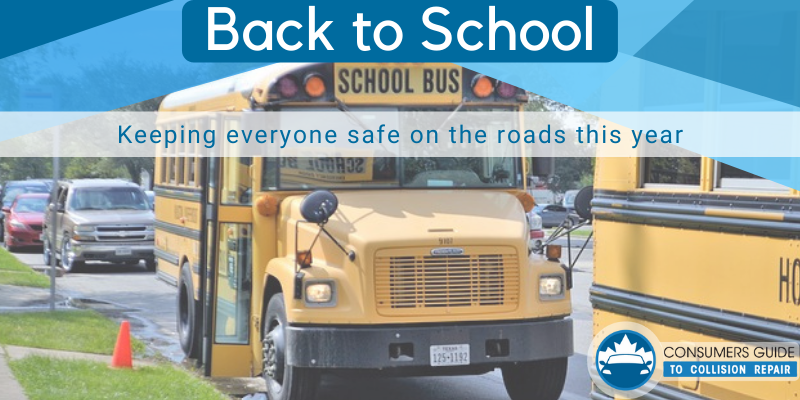
The 2020 school year is upon us, and while our homes might be quieter with our kids in the classroom (in-person or virtual), the roads have increased in volume with more commuters, school busses and pedestrians.
The spring and summer months saw a more relaxed driving experience due to most people staying home from school, or working from home due to Covid-19. But now that restrictions have eased and people are out and about, we must be actively aware of our surroundings when on the roads.
As adults, we are able to better predict the actions of drivers when interacting with traffic, whereas school-children may not be able to. They’re not as consciously aware of the dangers associated with moving vehicles which is why we, as responsible drivers, must err on the side of caution when out on the roads now, and for the rest of our driving careers.
Below we list some of the hazards of transportation throughout the school year, tips for avoiding these dangers and a few of the penalties for ignoring the road safety laws.
 Walking/Cycling:
Walking/Cycling:
Though walking or riding a bike may seem mundane and safe enough, there are added factors that can bring danger to those walking and cycling to school.
Distracted drivers: Be sure to always make eye contact with drivers before entering the roadway. Some drivers may not see pedestrians or cyclists right away if they’re distracted or focused on something else. Distracted drivers can face a penalty of $615 to $3,000 fine and 3 – 6 demerit points.
Distracted walkers: With devices easily harbouring our attention, it’s important to be aware of our surroundings when walking or crossing the street. Looking down at a device can make you unaware of turning or emerging cyclists and vehicles in your path.
Sidewalks: Always walk on the sidewalk, if one is available, and away from the street. If the street you’re walking down doesn’t have a sidewalk, walk on the opposite side of the road (towards oncoming traffic) so you can see vehicles approaching, and stay out of the way of traffic. For cyclists, if you’re over the age of 14 it’s illegal to ride on a sidewalk, according to some local bylaws (check the bylaws in your city to be sure). If you’re cycling to school and are 14 or older you must ride in the street no matter how busy, and if you’re under 18 the laws require you to wear a helmet. Failing to wear a proper helmet can result in an $85 fine while riding your bike on the sidewalk if you’re older than 14 can result in a $60 fine.
Crosswalks: All drivers, including cyclists, must stop and yield the whole roadway at school crossings and pedestrian crosswalks. Vehicles can only proceed once pedestrians and/or crossing guards have safely crossed. Failing to yield at pedestrian crossways can result in a fine up to $1000 and 4 demerit points. Cyclists also face an $85 fine for failing to walk their bike across a crossway.
 School Buses/Zones:
School Buses/Zones:
School buses have a long-standing record of being one of the safest options when it comes to children commuting to and from school. However, when it comes to risk factors surrounding school buses, 79 percent of school-aged fatalities (involving a bus) occur outside the bus, or in/near school bus loading zones.
Child education: It’s crucial to teach your children the importance of road safety from a young age. These days with the added factor of mobile devices we must also teach them to be aware and put their devices away when approaching a busy intersection. Though pedestrians have the right of way at crosswalks, some drivers are either ignorant of the fact, become impatient or are distracted when approaching crossways. It’s important to let kids know that drivers will not always be courteous when they are trying to cross the street.
When it comes to school bus safety teaching them that if they have to cross the street after exiting the bus to do so safely and within these guidelines:
- Walk about 10 feet ahead of the bus and make sure they can see the driver.
- Before stepping into the road, look both ways to ensure all vehicles have come to a stop before proceeding.
- Make eye contact with drivers before and while crossing the road to make sure they know they’re there.
- Once across the road, and safely on the sidewalk, stay as far back from the curb as possible

Driver education: It’s important to always be aware of your surroundings, especially when operating a motor vehicle. Becoming distracted or impatient while driving can create great risk, not just for the driver but for surrounding pedestrians as well. When it comes to driving in school zones always make sure to be driving at a safe speed and pay attention to the road signs that may indicate speed limit or a Community Safety Zone where there may be increased pedestrian traffic. With school zones come school buses as well, whether kids are getting on or off the bus all vehicles must stop when the bus has its lights flashing and stop-arm employed. This ensures that children are able to enter and exit the vehicle safely and cross the street if they need to. Being highly cautious and alert in these school zones is imperative to keeping a community safe from any kind of unnecessary tragedies. Failure to stop for a bus has hefty consequences of up to $2,000 in fines and six demerit points for a first offence.
We urge everyone to be patient and execute safe driving practices everyday, and not just when school is in session or there are high traffic volumes. Being a conscientious driver not only keeps you safe, but those in your surrounding communities as well. Let us know if you’ve had any close collision calls, road rage incidents, or fender benders by submitting your story through our “People – Personal Stories” tab.








